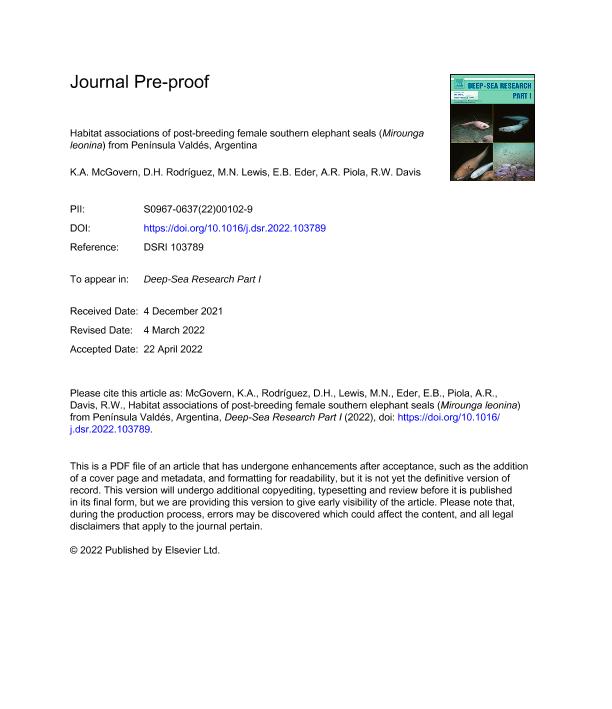Artículo
Habitat associations of post-breeding female southern elephant seals (Mirounga leonina) from Península Valdés, Argentina
McGovern, K.A.; Rodriguez, Diego Horacio ; Lewis, Mirtha Noemi
; Lewis, Mirtha Noemi ; Eder, Elena Beatriz
; Eder, Elena Beatriz ; Piola, Alberto Ricardo
; Piola, Alberto Ricardo ; Davis, R.W.
; Davis, R.W.
 ; Lewis, Mirtha Noemi
; Lewis, Mirtha Noemi ; Eder, Elena Beatriz
; Eder, Elena Beatriz ; Piola, Alberto Ricardo
; Piola, Alberto Ricardo ; Davis, R.W.
; Davis, R.W.
Fecha de publicación:
05/2022
Editorial:
Pergamon-Elsevier Science Ltd
Revista:
Deep Sea Research Part I: Oceanographic Research Papers
ISSN:
0967-0637
Idioma:
Inglés
Tipo de recurso:
Artículo publicado
Clasificación temática:
Resumen
Research on marine mammal habitat-associations often uses satellite remote sensing of sea surface temperature, chlorophyll concentration, and sea surface height to map mesoscale features, which may indicate areas of enhanced productivity and prey availability. However, for species that feed at depths >400 m, the increased productivity associated with mesoscale features observed near the surface may have little or no immediate effect on habitat-associations at depth. As a result, previous studies have found a weak correlation between mesoscale features and the movements of marine mammals. The advantage of biologging is that hydrographic variables are recorded in situ and at foraging depths using animal-borne instruments with sensors for temperature, conductivity (salinity), and dissolved oxygen. The goal of this study was to characterize the habitat-associations of female southern elephant seals (SES) from Península Valdés, Argentina during the post-breeding foraging trip. Although female SES exhibited significant habitat-associations with sea surface height anomaly and chlorophyll concentrations, the presence or absence of eddies was not predictive of foraging behavior, and the majority of foraging dives (74%) and prey encounters (77%) occurred in the absence of eddies. The strongest habitat-association was with deep (>500 m) and cold (3.73 ± 1.29 °C) subantarctic water, primarily during foraging dives from dusk to dawn. Female SES made most of their foraging dives (68%, mean maximum depth of 539 ± 226 m) and had the most prey encounters (67%) in Antarctic Intermediate Water (AAIW), which is formed near the Subantarctic Front on the northern flank of the Antarctic Circumpolar Current. Our results suggest that AAIW is the principal foraging habitat of female SES from Península Valdés, which may not be directly associated with near-surface mesoscale features. Future research on the habitat-associations for SES and other deep-diving marine mammals should focus on indices of foraging success and the hydrographic features of water masses at foraging depths, not mesoscale features observed near the surface.
Archivos asociados
Licencia
Identificadores
Colecciones
Articulos(CESIMAR)
Articulos de CENTRO PARA EL ESTUDIO DE SISTEMAS MARINOS
Articulos de CENTRO PARA EL ESTUDIO DE SISTEMAS MARINOS
Articulos(IIMYC)
Articulos de INSTITUTO DE INVESTIGACIONES MARINAS Y COSTERAS
Articulos de INSTITUTO DE INVESTIGACIONES MARINAS Y COSTERAS
Articulos(SEDE CENTRAL)
Articulos de SEDE CENTRAL
Articulos de SEDE CENTRAL
Citación
McGovern, K.A.; Rodriguez, Diego Horacio; Lewis, Mirtha Noemi; Eder, Elena Beatriz; Piola, Alberto Ricardo; et al.; Habitat associations of post-breeding female southern elephant seals (Mirounga leonina) from Península Valdés, Argentina; Pergamon-Elsevier Science Ltd; Deep Sea Research Part I: Oceanographic Research Papers; 185; 103789; 5-2022; 1-13
Compartir
Altmétricas



